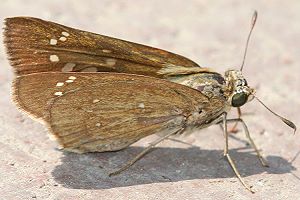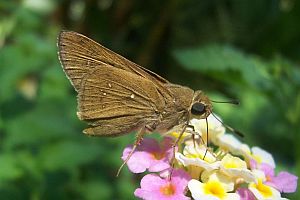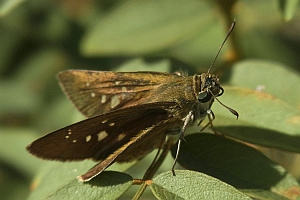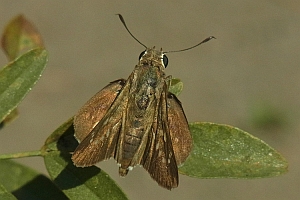

 +38Kontinente:EUASAF
+38Kontinente:EUASAF1. Lebendfotos
1.1. Falter
2. Diagnose
2.1. Erstbeschreibung
3. Biologie
3.1. Habitat
3.2. Nahrung der Raupe
- [Poaceae:] Phragmites australis (Schilf)
- [Poaceae:] Arundo donax (Riesenschilf, Spanisches Schilf, Pfahlrohr)
- [Poaceae:] Imperata cylindrica [= Imperata arundinacea] (Silberhaargras, Japanisches Blutgras)
- [Poaceae:] Tripidium ravennae [= Saccharum ravennae] (Ravennagras, Elefantengras)
- [Poaceae:] Saccharum kajkaiense [= Erianthus kajkaiensis]
- [Poaceae:] Saccharum officinarum (Zuckerrohr)
- [Poaceae:] Panicum miliaceum (Rispenhirse)
- [Poaceae:] Echinochloa colonum (Schamahirse)
- [Poaceae:] Piptatherum miliaceum [= Oryzopsis miliacea] (Südliche Grannenhirse, Gewöhnlicher Grannenreis)
- [Poaceae:] Ehrharta erecta ? (Panik-Veldtgras ?) [plausibel, aber bisher anscheinend nur als Fütterungspflanze in der Zucht belegt]
- [Poaceae:] Megathyrsus maximus ? [= Panicum maximum ?] [Originalquelle noch nicht studiert]
- [Poaceae:] Oryza sp. ? (Reis ?)
- [Poaceae:] Triticum sp. ? (Weizen ?)
Cock (2010: 43) unterzieht die bis 2009 publizierten Literaturangaben zur Raupe einer kritischen Analyse: "The reported food plants of P. thrax are all grasses, but almost all published records seem to be secondary sources, and I have failed to track down many original food plant records. For example, it has been reported several times as a pest of rice, yet Heinrichs & Barrion (2004) do not mention this species in their comprehensive review of rice pests in West Africa, although they do include P. mathias, which is well recognised as a minor pest of rice (e.g. IRRI 1983). The food plant records from the Arabian Peninsula are limited. Larsen & Larsen (1980) give “grasses, including rice, wheat and millet”, but this is probably based on sources from outside the region. Larsen’s (1984) illustration of a caterpillar on a millet leaf is misidentified (see discussion below). Dickson & Kroon (1978), presumably based on the notes of G.C. Clark from South Africa, give the food plant as Imperata cylindrica (L.) Raeusch. (as I. arundinacea), and add that it was reared on Ehrharta erecta Lam. and other grasses. Pringle et al. (1994) in the revision of Dickson & Kroon (1978) imply that E. erecta is a food plant, but this is probably based on the rearing food plant record from the earlier edition. Larsen (1991) reports that the caterpillars feed on grasses (Ehrata, Oryza, Imperata) and it may be a minor pest of rice. Larsen (2005) expands this to a “wide array of Poaceae, including Oryza, Ehrhata and Imperata”. The possibility of confusion between the two Pelopidas spp. suggests that all records not based on reared voucher specimens are open to question. As far as I can tell, of those mentioned above, the only unequivocal field record of a food plant for P. thrax is G.C. Clark’s South African record on I. cylindrica. Clark (1978) provides excellent paintings of the life history on “grass” (Dickson & Kroon 1978, Plate 32)."
Cock (2010: 45) berichtet dann über seine eigenen Raupenfunde an Saccharum kajkaiense im Oman.
Benyamini & John (2020: 178-179) berichten aus dem Levant: "Recorded hostplants: mainly broadleaved grasses: Poaceae (Gramineae) - Panicum miliaceum [M], Echinochloa colonum [M], Phragmites australis [M] (illustr.), Piptatherum miliaceum (syn. Oryzopsis miliacea and Saccharum officinarum [C] (Benyamini, 2010c), DB, LHP). Arundo donax is a possible hostplant in Cyprus (Martin & Russell, 2013; EJ, pers. obs.)." "[M]" steht dabei für "main or preferred hostplant" und "[C]" für "cultivated/ non native hostplant".
Wolfgang Wagner fasst seine eigenen Beobachtungen auf Rhodos zusammen: "Die Raupe lebt an breitblättrigen, robusten Gräsern. Auf Rhodos fand ich Eier, Raupen und Puppen an Arundo, Phragmites und Tripidium ravennae."
Mittlerweile zeichnet sich also ab, dass tatsächlich etliche breitblättrige Süßgräser von dieser Art genutzt werden, wahrscheinlich noch mehr als die bisher bekannten. Auch Reis und Weizen passen da durchaus ins Schema, aber ihre Nutzung ist noch nicht abgesichert - sicher ist nur, dass sie eine allenfalls ganz untergeordnete Rolle spielen und dass sich Angaben zu Schäden an Reis sich auf Pelopidas mathias beziehen.
(Autor: Erwin Rennwald)
4. Weitere Informationen
4.1. Andere Kombinationen
- Gegenes thrax Hübner, [1821] [Originalkombination]
4.2. Synonyme
- Pelopidas midea Walker, 1870
4.3. Taxonomie
Als Hübner [1821] auf Tafel 319 seiner "Sammlung exotischer Schmetterlinge" "Gegenes thrax" darstellte, wollte er möglicherweise nur einen neuen Gattungsnamen für Linnés Papilio thrax ins Leben rufen. Sein Falter weicht aber doch so sehr von Linnées Tier ab, dass schnell klar war, dass es sich um zwei Arten handelt, die heute nicht nur in unterschiedlichen Gattungen (Erionota bzw. Pelopidas) sondern auch unterschiedlichen Tribus (Baorini bzw. Erionotini) stehen. Da Hübner [1821] keinen Bezug zu Linnées Art herstellte, müssen wir seine Darstellung als Beschreibung einer neuen Art ansehen, die nur zufällig das gleiche Artepitethon hat wie Linnées Papilio thrax.
Erionota thrax (Linnaeus, 1758) ist im warmfeuchten Südostasien zu Hause und lebt als Raupe an Bananenblättern, Pelopidas thrax (Hübner [1821]) ist hingegen eine Trockengebietsart die von Griechenland an südostwärts durch die Türkei und den Iran sowie südwärts durch ganz Afrika verbreitet ist.
Doch es kommt noch schlimmer: Die Abbildung von Celaenorrhinus thrax Geyer, 1837 von Java passt zu keiner dieser beiden Arten, sondern ist als Synonym von Hesperia mathias Fabricius, 1798 - jetzt Pelopidas mathias (Fabricius, 1798) - anzusehen.
(Autor: Erwin Rennwald)
4.4. Faunistik
Bis 24. Dezember 2022 stand an dieser Stelle: "Locus typicus ist Java (Indonesien)". Dies ist unzutreffend und beruhte darauf, dass wir die aus Java beschriebene Celaenorrhinus thrax irrtümlich hierher gestellt hatten. Dieser Fehler hat sich heute in der Literatur fest eingebürgert. Tatsächlich ist Caelorrhinus thrax als Synonym der aus Indien beschriebenen Pelopidas mathias anzusehen. Hübner [1821] nannte keinen Fundort zu seiner "Gegenes thrax". Typenfundort hat daher "Terra" zu gelten. Die Art ist in Afrika weit verbreitet. Benyamini & John (2020: 178-179) zeigen für den "Levant eine Verbreitungskarte mit Vorkommen entlang des Nils in Ägypten, entlang Rotem Meer nach Israel und am Ostrand des Mittelmeers durch Syrien bis in die Türkei und Zypern. Ostwärts soll das Vorkommen durch den Iran bis Pakistan und den Nordwesten Indiens reichen.
Die ausgesprochene Trockengebiets-Art erreicht unser europäisches Bearbeitungsgebiet von der Ostküste des Mittelmeers aus. Angaben gibt es hier von den der Türkei vorgelagerten Inseln Zypern, Samos, Rhodos, Kos, Kastellorizo und Kalymnos.
Langourov et al. (2022) melden unter der Überschrift "The invasion continues" den ersten Nachweis für die Sporaden-Inseln: "Greece, Alonnisos Island: [16] between Paralia Megalos Mourtias to Alonnisos, 39.1429911°N, 23.8473118°E, 10.ix.2022, 1 ♂."
(Autoren: Erwin Rennwald & Jürgen Hensle)
4.5. Publikationsjahr der Erstbeschreibung
Die Tafeln in Hübners „Sammlung exotischer Schmetterlinge“ sind nicht nummeriert. Hemming (1937: 330) lokalisiert thrax in der Lieferung 77, und zwar auf der Tafel [150]. Die Tafelnummern stehen in eckigen Klammern, weil Hemming sie aus der späteren Auflage der „Sammlung exotischer Schmetterlinge“ von Geyer übernahm. Aus der Aufstellung von Hemming (1937: 342) geht hervor, dass die Tafel [150] zwischen dem 1. Januar und Mitte Mai 1821 erschien.
(Autor: Jürgen Rodeland)
4.6. Literatur
- Benyamini, D. & E. John (2020): Butterflies of the Levant and nearby areas. Vol. II: Papilionidae, Pieridae & Hesperiidae. - 208 S.; Eit-Arye (Israel) (4D Microrobotics).
- Hemming, F. (1937): A bibliographical and systematic account of the entomological works of Jacob Hübner and of the supplements thereto by Carl Geyer Gottfried Franz von Frölich and Gottlieb August Wilhelm Herrich-Schäffer. Volume 1: i-xxxiv, 1-605. London (Royal Entomological Society of London).
- Erstbeschreibung: Hübner, J. [1819-1827]: Sammlung exotischer Schmetterlinge. Zweiter Band. [1]-[10], pl. [1]-[492]. Augsburg (Verlag der Hübner'schen Werke).
- Langourov, M., Simov, N. & S. Abadjiev (2022): The invasion continues: Hierodula tenuidentata (Mantodea), Leptoglossus occidentalis (Hemiptera) and Pelopidas thrax (Lepidoptera) already on the island of Alonnisos. — Historia naturalis bulgarica, 44 (11): 137–144. https://doi.org/10.48027/hnb.44.112. [PDF auf nmnhs.com/historia-naturalis-bulgarica]
- Zerganipour, A., Esfandiari, M. & M. M. Rabieh (2021): Geometric morphometric study of sexual dimorphism and its associated allometry in wings of Pelopidas thrax (Lep.: Hesperiidae). — Journal of Insect Biodiversity and Systematics 7 (4): 391-407. [PDF auf biotaxa.org]























































